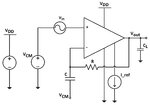Junus2012
Advanced Member level 5
Dear friends
Before I have posted a thread about how to measure the AC open loop characteristics using the attached circuit and graph. these are from Allen Holberg and Jackob Baker
My teacher has told me that this circuit is not suitable for showing the DC gain if it is very high like 100 dB or something like that. this is due to the impossibility for finding real signal source that can provide us with micro volts . Using a divider resistor to drop a voltage in mV from a signal source can add huge amount of noise to the input
Therefore, I must find an alternative method for testing only the DC gain of the op-amp
I am looking for your discussion
Thank you very much
Before I have posted a thread about how to measure the AC open loop characteristics using the attached circuit and graph. these are from Allen Holberg and Jackob Baker
My teacher has told me that this circuit is not suitable for showing the DC gain if it is very high like 100 dB or something like that. this is due to the impossibility for finding real signal source that can provide us with micro volts . Using a divider resistor to drop a voltage in mV from a signal source can add huge amount of noise to the input
Therefore, I must find an alternative method for testing only the DC gain of the op-amp
I am looking for your discussion
Thank you very much
Attachments
Last edited:

